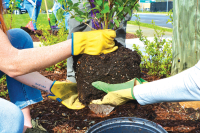Strawberry wine and its place in Smokies lore
Jack Coburn was a regional entrepreneur who had come to the Smokies in the 1890s. Jack liked to laugh, drink, tell stories, and fight. He was an expert boxer. With an unlit cigar stub clinched between his teeth, Jack rode around on a horse named Button looking after his many interests and most everyone else’s, too.
He and Horace Kephart became lifelong friends after Coburn helped him obtain permission from a mining company that had gone into litigation to live in one of its vacant cabins located near Medlin, where the Sugar Fork enters Hazel Creek 10 miles or so above its former confluence with the Little Tennessee River (now Lake Fontana) at Bushnell (now inundated).
Coburn had arranged for a mountaineer named Granville Calhoun to meet Kephart at the depot at the mouth of Hazel Creek and lead him up to the cabin. Therein lies the context for one of the region’s most legendary encounters.
Granville and his wife, the former Lillie Hall, built a store at Medlin. He worked as a timber cruiser and dam builder and caretaker for the mine on the Little Fork.
With the coming of the park and the flooding of Lake Fontana in 1944, they had to move to Bryson City. When I visited Granville in early 1973, he was going on 100 and communicated with visitors via Seymour’s assistance. Even so, sitting upright in a kitchen chair, he was still the man remembered by a contemporary as being “larger than life.”
Related Items
In Strangers in High Places: The Story of the Great Smoky Mountains (1967), Michael Frome aptly described Granville as “squire of Hazel Creek ... a man with a sparkle in his eye and flood of mountain stories rolling from his lips.” And the accounts Granville passed along to regional columnists like Carson Brewer (Knoxville Sentinel) as well as historians like Michael Frome of an incapacitated dude named Horace Kephart have all the earmarks of a tall tale out of Mark Twain. The tale varied somewhat from listener to listener.
In a chapter devoted to Kephart, Frome reported after interviewing Granville that Kephart “transfixed as with some distant image” ... held onto a mule “as best he could” for 16 miles. Arriving at Granville’s home, he was undressed, put to bed, and offered milk. Kephart declined that beverage in favor of “Smoky Mountain strawberry wine,” which Frome was told “is reputed to awaken the dead and delight the angels.” Thereafter the patient was restricted to “sweet milk.”
In Carson Brewer’s version, published in Valley So Wild: A Folk History (1975), Granville recalled, 70 or so years later, that the strawberry wine was “a pale red wine and you could smell it all over the room when I took out the stopper.”
I noted in an introduction to the 1976 reissue of Our Southern Highlanders by the University of Tennessee Press that Frome’s “presentation conflicts with available sources.” Neither Frome nor by extension his informant indicated any awareness that Kephart was not coming directly from St. Louis to Hazel Creek, with a brief layover in Sylva.
Thirty-six years later, in the “Afterword” to Gary Carden’s play Outlander (2012), I considered the matter again in greater detail:
Kephart kept a diary following his departure for the Smokies. The two volumes are presumably lost, but being an inveterate library cataloger he did create an “Index to Diary” that has been preserved in Journal 1 of the 27 journals archived in Special Collections at Hunter Library, Western Carolina University. (The index is online via the “Horace Kephart: Revealing an Enigma” digital website maintained by WCU.) On Nov. 1 under the heading “Off for Medlin” he left the Dicks Creek camp near Sylva via train, making seven diary entries along the way to the Bushnell depot at the mouth of Hazel Creek. The eighth entry for that day is “Trip to Medlin” followed by diary notations.
George Frizzell, curator of the Kephart materials at WCU, and Daniel S. Pierce, chairman of the Department of History at UNC-Asheville and author of Great Smokies: From Natural Habitat to National Park (2000), agree with my conclusion — based on currently available documentation, there was evidently no three-week interval of “torpor and tremens” and “spoon-feeding.”
Kephart is to this day the quintessential “outlander” in southern Appalachian and Smokies lore. Tensions regarding who is an outlander and who is a “highlander” are still alive and well, especially in the socio-geographic micro-climate of the immediate Smokies region. The native highlander, with innate sensibilities and wily intuitiveness often gets it right — but not always.
Kephart certainly didn’t get it right all of the time. Only after having been anointed with potions of homemade “strawberry wine” was the greenhorn “awakened from the dead” (as it were) and enabled to proceed with his quixotic journey into the Land of Beyond.









